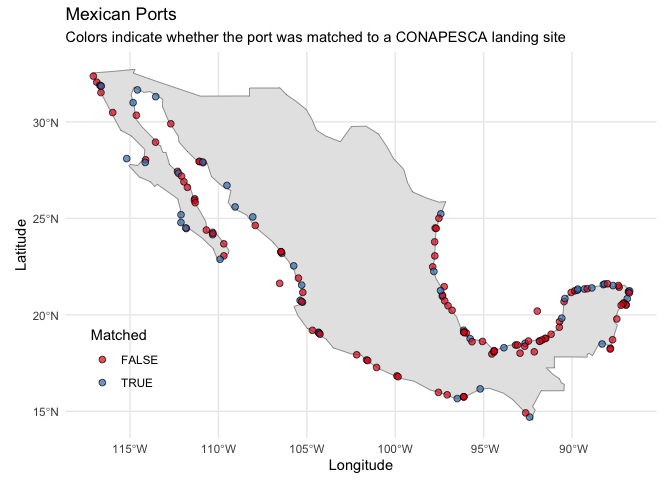mex_ports
A geospatial dataset of Mexican ports
By: Emma Zgonena, Renato Molina & Juan Carlos Villaseñor-Derbez
Cite all versions as: as: Zgonena et al., 2025. A geospatial dataset of Mexican ports. DOI: 10.5281/zenodo.15778574

Overview
This repository contains data and code to build a geospatial dataset of the major ports of Mexico, some of which are included in CONAPESCA’s landing data. It is intended to interface with other data in mex_fisheries, such as vessel- and port-level landings information.
How the data are built
1) Extract port information and location
The final data, mex_ports, is a culmination of information from the
files mexian_ports.csv and mex_large_scale_landing_ports.csv that
are correlated through mex_ports_dictionary.csv.
The information originates from the pdf titled
catastro.pdf, which contains information on
Mexican ports from the Mexican Secretaria de Comunicaciones y
Transportes and the Departamento de Catastro, Instalaciones y Recintos.
K+The following key variables were manually extracted from the PDF to
create mexian_ports.csv:
- The inputs for
port_idare labeled as ‘Clv. del puerto’ incatastro.pdf - The inputs for
municipality_code(renamedmunicipality_idin finalmex_portscleaned data) andmunicipality_nameare found labeled together under ‘Municipio’ incatastro.pdf - The inputs for
port_nameare labeled asNombre del Puertoincatastro.pdf - The inputs for
longitudeandlatitudeare labeled asLongitudandLatutidrespectively incatastro.pdf
Note: 155 individual ports were identified in
mexican_ports.csv, 4 of which are on lakes and therefore are not coastline ports.
2) Identify ports with recorded fisheries landings
The information in mex_large_scale_landing_ports.csv is from Mexico’s
fisheries production data. Code showing the extraction is included in
01_get_large_scale_ports.R. The
data do not include port_id, and instead use CONAPESCA’s system of
unique identifiers (mex_ports_id). We manually built a dictionary
(mex_ports_dictionary.csv) that
allowed us to link port_ids to landinge_site_keys.
Note: 51 of the total ports in
mexican_ports.csvcan be matched to ports inmex_large_scale_landing_ports.csv
3) Combine data
The final data, mex_ports, was created using the
script titled 03_combine_sources.R.
This script cleans and retains relevant columns from the dictionary,
omitting lake ports (4) that are not relevant to the set. It then
combines the objects through their corresponding port_id. Finally, the
data is standardized in name and made further accessible through the
addition of tabular and geospatial file versions.
Note: The final data set has 151 ports, of which 55 can be matched to CONAPESCA’s
mex_ports_id
Metadata
Data files
The data are available in three formats:
- mex_ports.gpkg:
A geopackage in
EPSG:4326. This is the recommended source because it is already a spatial object. - mex_ports.rds: Tabular format as an R object.
- mex_ports.csv: Tabular format as a comma-separated values file.
Column specifications across all are the same
municipality_idormunicipality_code: character. 5-digit code that acts as a unique identifier for each municipality.municipality_name: character. Official name of municipality.port_id: character. 5-digit code that acts as a unique identifier for each port.port_name: character. Official name of port. Originally labeled under ‘Nombre del Puerto’.landing_site_id: character. 3-digit alphanumeric string that acts as a unique identifier for a what CONAPESCA considers a landing site. Note that ports not matched to a landing site id will showNAin this column.latitude: numeric. Latitude in decimal degrees for the location of the port.longitude: numeric. Longitude in decimal degrees for the location of the port.
Using the data
Build a table of landing sites an d corodinates
#Load packages
library(tidyverse)
# Load the data using the csv file
mex_ports <- read_csv(
file = "https://github.com/mex-fisheries/mex_ports/raw/refs/heads/main/data/clean/mex_ports.csv") # You can read the rds file using read_RDS(url("url/to/file.rds"))
#> Rows: 151 Columns: 7
#> ── Column specification ────────────────────────────────────────────────────────
#> Delimiter: ","
#> chr (5): municipality_id, municipality_name, port_id, port_name, landing_sit...
#> dbl (2): longitude, latitude
#>
#> ℹ Use `spec()` to retrieve the full column specification for this data.
#> ℹ Specify the column types or set `show_col_types = FALSE` to quiet this message.
# A quick glimpse at the data
glimpse(mex_ports)
#> Rows: 151
#> Columns: 7
#> $ municipality_id <chr> "02005", "02001", "02001", "02001", "02001", "02001"…
#> $ municipality_name <chr> "PLAYAS DE ROSARITO", "ENSENADA", "ENSENADA", "ENSEN…
#> $ port_id <chr> "02001", "02002", "02003", "02004", "02005", "02006"…
#> $ port_name <chr> "ROSARITO", "LA MISION", "El SAUZAL", "MARINA CORAL"…
#> $ landing_site_id <chr> NA, NA, "02A", NA, "02B", NA, NA, NA, "02C", "02D", …
#> $ longitude <dbl> -117.0731, -116.8801, -116.7043, -116.6612, -116.625…
#> $ latitude <dbl> 32.3692, 32.0550, 31.8944, 31.8622, 31.8522, 31.5176…
# Let's get all ports that can be matched to landing site from CONAPESCA's data
mex_ports |>
filter(!is.na(landing_site_id)) |>
select(port_name, landing_site_id, longitude, latitude)
#> # A tibble: 50 × 4
#> port_name landing_site_id longitude latitude
#> <chr> <chr> <dbl> <dbl>
#> 1 El SAUZAL 02A -117. 31.9
#> 2 ENSENADA 02B -117. 31.9
#> 3 ISLA CEDROS 02C -115. 28.1
#> 4 SAN FELLIPE 02D -115. 31.0
#> 5 GURRERO NEGRO 03L -114. 27.9
#> 6 A. LOPEZ MATEOS 03D -112. 25.2
#> 7 SAN CARLOS 03B -112. 24.8
#> 8 PUERTO ALCATRAZ 03C -112. 24.5
#> 9 CABO SAN LUCAS 03E -110. 22.9
#> 10 SANTA ROSALIA 03H -112. 27.3
#> # ℹ 40 more rows
Build a map
The code below is used to build the figure at the top of this document.
# Load packages
library(rnaturalearth)
library(sf)
library(tidyverse)
# This time we read the geopackage
mex_ports_sf <- st_read("https://github.com/mex-fisheries/mex_ports/raw/refs/heads/main/data/clean/mex_ports.gpkg",
quiet = TRUE)
mex <- ne_countries(country = "Mexico")
ggplot(data = mex) +
geom_sf() +
geom_sf(data = mex_ports_sf,
mapping = aes(fill = !is.na(landing_site_id)),
color = "black",
shape = 21,
size = 2,
alpha = 0.7) +
theme_minimal() +
theme(legend.position = "inside",
legend.position.inside = c(0.1, 0.2)) +
scale_fill_brewer(palette = "Set1") +
labs(title = "Mexican Ports",
subtitle = "Colors indicate whether the port was matched to a CONAPESCA landing site",
x = "Longitude",
y = "Latitude",
fill = "Matched")